[English] 日本語
 Yorodumi
Yorodumi- PDB-2jrr: Solution NMR Structure of Q5LLS5 from Silicibacter pomeroyi. Nort... -
+ Open data
Open data
- Basic information
Basic information
| Entry | Database: PDB / ID: 2jrr | ||||||
|---|---|---|---|---|---|---|---|
| Title | Solution NMR Structure of Q5LLS5 from Silicibacter pomeroyi. Northeast Structural Genomics Consortium target SiR90 | ||||||
 Components Components | Uncharacterized protein | ||||||
 Keywords Keywords | STRUCTURAL GENOMICS / UNKNOWN FUNCTION / solution NMR Structure / Protein / SiR90 / PSI-2 / Protein Structure Initiative / Northeast Structural Genomics Consortium / NESG | ||||||
| Function / homology | q5lls5 like domains / HSP40/DNAj peptide-binding domain / Zinc finger, CHCC-type / Zinc-finger domain / Sandwich / Mainly Beta / Zinc finger CHCC-type domain-containing protein Function and homology information Function and homology information | ||||||
| Biological species |  Silicibacter pomeroyi (bacteria) Silicibacter pomeroyi (bacteria) | ||||||
| Method | SOLUTION NMR / simulated annealing | ||||||
 Authors Authors | Swapna, G.V.T. / Tejero, R. / Jiang, M. / Cunningham, K. / Maglaqui, M. / Owens, L. / Liu, J. / Wang, H. / Acton, T.B. / Xiao, R. ...Swapna, G.V.T. / Tejero, R. / Jiang, M. / Cunningham, K. / Maglaqui, M. / Owens, L. / Liu, J. / Wang, H. / Acton, T.B. / Xiao, R. / Baran, M.C. / Rost, B. / Montelione, G.T. / Northeast Structural Genomics Consortium (NESG) | ||||||
 Citation Citation |  Journal: To be Published Journal: To be PublishedTitle: Solution NMR Structure of Q5LLS5 from Silicibacter pomeroyi. Authors: Swapna, G.V.T. / Tejero, R. / Jiang, M. / Cunningham, K. / Maglaqui, M. / Owens, L. / Liu, J. / Wang, H. / Acton, T.B. / Xiao, R. / Baran, M.B. / Rost, B. / Montelione, G.T. | ||||||
| History |
|
- Structure visualization
Structure visualization
| Structure viewer | Molecule:  Molmil Molmil Jmol/JSmol Jmol/JSmol |
|---|
- Downloads & links
Downloads & links
- Download
Download
| PDBx/mmCIF format |  2jrr.cif.gz 2jrr.cif.gz | 403 KB | Display |  PDBx/mmCIF format PDBx/mmCIF format |
|---|---|---|---|---|
| PDB format |  pdb2jrr.ent.gz pdb2jrr.ent.gz | 337.8 KB | Display |  PDB format PDB format |
| PDBx/mmJSON format |  2jrr.json.gz 2jrr.json.gz | Tree view |  PDBx/mmJSON format PDBx/mmJSON format | |
| Others |  Other downloads Other downloads |
-Validation report
| Summary document |  2jrr_validation.pdf.gz 2jrr_validation.pdf.gz | 532.4 KB | Display |  wwPDB validaton report wwPDB validaton report |
|---|---|---|---|---|
| Full document |  2jrr_full_validation.pdf.gz 2jrr_full_validation.pdf.gz | 649.8 KB | Display | |
| Data in XML |  2jrr_validation.xml.gz 2jrr_validation.xml.gz | 28 KB | Display | |
| Data in CIF |  2jrr_validation.cif.gz 2jrr_validation.cif.gz | 43.6 KB | Display | |
| Arichive directory |  https://data.pdbj.org/pub/pdb/validation_reports/jr/2jrr https://data.pdbj.org/pub/pdb/validation_reports/jr/2jrr ftp://data.pdbj.org/pub/pdb/validation_reports/jr/2jrr ftp://data.pdbj.org/pub/pdb/validation_reports/jr/2jrr | HTTPS FTP |
-Related structure data
| Similar structure data | |
|---|---|
| Other databases |
- Links
Links
- Assembly
Assembly
| Deposited unit | 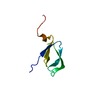
| |||||||||
|---|---|---|---|---|---|---|---|---|---|---|
| 1 |
| |||||||||
| NMR ensembles |
|
- Components
Components
| #1: Protein | Mass: 7516.512 Da / Num. of mol.: 1 Source method: isolated from a genetically manipulated source Source: (gene. exp.)  Silicibacter pomeroyi (bacteria) / Strain: DSS-3, DSM 15171 Silicibacter pomeroyi (bacteria) / Strain: DSS-3, DSM 15171Description: The protein is a monomer by gel filtration chromatography and static light scattering. Gene: SP03846 / Plasmid details: Plasmid / Plasmid: pET21 / Production host:  |
|---|
-Experimental details
-Experiment
| Experiment | Method: SOLUTION NMR | ||||||||||||||||||||||||||||||||||||||||||||||||||||
|---|---|---|---|---|---|---|---|---|---|---|---|---|---|---|---|---|---|---|---|---|---|---|---|---|---|---|---|---|---|---|---|---|---|---|---|---|---|---|---|---|---|---|---|---|---|---|---|---|---|---|---|---|---|
| NMR experiment |
|
- Sample preparation
Sample preparation
| Details |
| ||||||||||||||||||||||||||||||||||||||||||||||||||||
|---|---|---|---|---|---|---|---|---|---|---|---|---|---|---|---|---|---|---|---|---|---|---|---|---|---|---|---|---|---|---|---|---|---|---|---|---|---|---|---|---|---|---|---|---|---|---|---|---|---|---|---|---|---|
| Sample |
| ||||||||||||||||||||||||||||||||||||||||||||||||||||
| Sample conditions |
|
-NMR measurement
| NMR spectrometer |
|
|---|
- Processing
Processing
| NMR software |
| ||||||||||||||||||||||||||||||||||||||||||||
|---|---|---|---|---|---|---|---|---|---|---|---|---|---|---|---|---|---|---|---|---|---|---|---|---|---|---|---|---|---|---|---|---|---|---|---|---|---|---|---|---|---|---|---|---|---|
| Refinement | Method: simulated annealing / Software ordinal: 1 Details: The structures are based on a total of 819 conformationally restricting NOE-derived distance constraints, 52 dihedral angle constraints, and 26 hydrogen bond constraints.(14.5 constraints ...Details: The structures are based on a total of 819 conformationally restricting NOE-derived distance constraints, 52 dihedral angle constraints, and 26 hydrogen bond constraints.(14.5 constraints per residue, 5.2 long-range constraints per residue, computed for residues 1-62 by PSVS 1.3). Residues 62-67 correspond to the Histidines of the C-terminal tag and could not be assigned. Structure determination was performed iteratively using AutoStructure (XPLOR-NIH). After a final XPLOR calculation using the constraints derived from AutoStructure, the 20 lowest energy structures out of 100 were further refined by restrained Molecular dynamics/Energy minimization in explicit water (CNS). The C-terminal HIS-tag residues of the protein were included in the calculations as well as the deposition. Coordinates for the following residues are not well determined: 1-7,18-29,46-48,58-67. The structure was determined using standard Triple resonance NMR experiments. Automated backbone assignments were made using AutoAssign and the sidechain assignments were completed manually. Automatic NOESY assignments as well as distance, dihedral angle and hydrogen-bond constraints were determined using AutoStructure. Structure quality factors, where ordered residues comprise: 8-17,30-45,49-57. RMSD of BB 0.5A, heavy atoms 1.0A. Ramachandran statistics for ordered residues: Most favoured: 91.1%, Additionally allowed: 8.9%, Generally allowed: 0.0%, Unfavourable: 0%. Procheck scores for ordered residues (raw/Z) phi-psi: -0.56/-1.89; all -0.33/-1.95. Molprobity clash score (raw/Z) 17.48/-1.47. RPF scores for goodness of fit to NOESY data: recall: 0.943, precision: 0.92, F-measure: 0.93. Final DP-score 0.795. | ||||||||||||||||||||||||||||||||||||||||||||
| NMR representative | Selection criteria: lowest energy | ||||||||||||||||||||||||||||||||||||||||||||
| NMR ensemble | Conformer selection criteria: structures with the lowest energy Conformers calculated total number: 100 / Conformers submitted total number: 20 | ||||||||||||||||||||||||||||||||||||||||||||
| NMR ensemble rms | Distance rms dev: 0.02 Å |
 Movie
Movie Controller
Controller


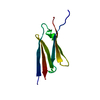

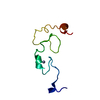

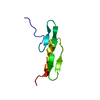

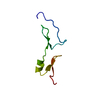
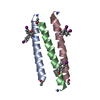
 PDBj
PDBj HSQC
HSQC